Research Progress and Perspectives on Wastewater-Based Epidemiology: A Bibliometric Analysis
Abstract
1. Introduction
2. Materials and Methods
2.1. Data Sources and Retrieval Strategies
2.2. Data Analysis and Visualization
3. Results
3.1. Trend of Published Articles
3.2. Subject Distribution and Published Journals
3.3. Main Publishing Countries
3.4. Main Publishing Institutions and Authors
3.5. Highly Cited Papers
3.6. Main Research Hotspots
3.6.1. Keyword Co-Occurrence Analysis
3.6.2. Burst Analysis
4. Discussion
4.1. Emerging Analysis and Detection Techniques for Biomarkers
4.2. Applications of Big Data and Artificial Intelligence
4.3. Policy and Public Health Practice
5. Conclusions
- (1)
- The emergence of the COVID-19 pandemic has significantly catalyzed the advancement of WBE. An expeditious augmentation in the number of research publications pertaining to WBE has been observed, particularly in the last three years. The USA has consistently exhibited a preeminent research capacity globally. The three institutions contributing the highest number of publications include the University of Queensland, the University of Bath, and the University of Antwerp. The top-tier journals in this field are Science of The Total Environment, Water Research, and Environmental Science & Technology. Notably, Mueller JF, Thomas KV, and Thai PK from the University of Queensland were major contributors to the realm of WBE research.
- (2)
- The analysis of research status and hotspots in the WBE field, based on highly co-cited literature, keyword co-occurrence, and burst keywords, reveals that the core focus of WBE research encompasses the surveillance of illicit drugs, psychoactive substances, and viruses. Future research should prioritize the development of emerging biomarker detection and analysis techniques to facilitate real-time updates and early warnings of sewage epidemiological data. Concurrently, integrating big data technology (e.g., artificial intelligence and cloud computing) could assist researchers in enhancing the efficiency, accuracy, and practicality of their investigations. Upon establishing unified research standards and methodologies, the integration of epidemiological data with clinical surveillance data from medical institutions may provide a more comprehensive foundation for public health research and decision-making.
- (3)
- Distinct literature databases exhibit varying coverage across disciplines and fields. In this study, the WOSCC database was solely employed, and the search terms were only for part of the subject (i.e., title, abstract, keywords, etc.), potentially overlooking contributions from certain fields and consequently yielding incomplete research outcomes. Future endeavors could encompass the utilization of databases such as PubMed, Scopus, Google Scholar, and Dimensions to broaden the search purview and furnish more comprehensive data substantiation.
Author Contributions
Funding
Data Availability Statement
Conflicts of Interest
References
- Daughton, C.G. Illicit Drugs in Municipal Sewage. Pharmaceuticals and Care Products in the Environment; ACS Symposium Series; American Chemical Society: Washington, DC, USA, 2001; pp. 348–364. [Google Scholar]
- Gagliano, E.; Biondi, D.; Roccaro, P. Wastewater-based epidemiology approach: The learning lessons from COVID-19 pandemic and the development of novel guidelines for future pandemics. Chemosphere 2023, 313, 137361. [Google Scholar] [CrossRef] [PubMed]
- Boogaerts, T.; Jurgelaitiene, L.; Dumitrascu, C.; Kasprzyk-Hordern, B.; Kannan, A.; Been, F.; Emke, E.; de Voogt, P.; Covaci, A.; van Nuijs, A.L. Application of wastewater-based epidemiology to investigate stimulant drug, alcohol and tobacco use in Lithuanian communities. Sci. Total Environ. 2021, 777, 145914. [Google Scholar] [CrossRef] [PubMed]
- Wen, J.; Duan, L.; Wang, B.; Dong, Q.; Liu, Y.; Chen, C.; Huang, J.; Yu, G. In-sewer stability assessment of 140 pharmaceuticals, personal care products, pesticides and their metabolites: Implications for wastewater-based epidemiology biomarker screening. Environ. Int. 2024, 184, 108465. [Google Scholar] [CrossRef] [PubMed]
- González-Mariño, I.; Rodil, R.; Barrio, I.; Cela, R.; Quintana, J.B. Wastewater-based epidemiology as a new tool for estimating population exposure to phthalate plasticizers. Environ. Sci. Technol. 2017, 51, 3902–3910. [Google Scholar] [CrossRef] [PubMed]
- Ahmed, W.; Angel, N.; Edson, J.; Bibby, K.; Bivins, A.; O’Brien, J.W.; Choi, P.M.; Kitajima, M.; Simpson, S.L.; Li, J. First confirmed detection of SARS-CoV-2 in untreated wastewater in Australia: A proof of concept for the wastewater surveillance of COVID-19 in the community. Sci. Total Environ. 2020, 728, 138764. [Google Scholar] [CrossRef] [PubMed]
- Huizer, M.; Ter Laak, T.L.; de Voogt, P.; van Wezel, A.P. Wastewater-based epidemiology for illicit drugs: A critical review on global data. Water Res. 2021, 207, 117789. [Google Scholar] [CrossRef] [PubMed]
- Rahman, A.; Kang, S.; Wang, W.; Garg, A.; Maile-Moskowitz, A.; Vikesland, P.J. Nanobiotechnology enabled approaches for wastewater based epidemiology. TrAC Trends Anal. Chem. 2021, 143, 116400. [Google Scholar] [CrossRef] [PubMed]
- Sims, N.; Kasprzyk-Hordern, B. Future perspectives of wastewater-based epidemiology: Monitoring infectious disease spread and resistance to the community level. Environ. Int. 2020, 139, 105689. [Google Scholar] [CrossRef]
- Xu, M.; Yang, M.; Xie, D.; Ni, J.; Meng, J.; Wang, Q.; Gao, M.; Wu, C. Research trend analysis of composting based on Web of Science database. Environ. Sci. Pollut. R. 2021, 28, 59528–59541. [Google Scholar] [CrossRef]
- Huang, S.; Yoshitake, K.; Watabe, S.; Asakawa, S. Environmental DNA study on aquatic ecosystem monitoring and management: Recent advances and prospects. J. Environ. Manag. 2022, 323, 116310. [Google Scholar] [CrossRef]
- Zhao, L.; Dai, T.; Qiao, Z.; Sun, P.; Hao, J.; Yang, Y. Application of artificial intelligence to wastewater treatment: A bibliometric analysis and systematic review of technology, economy, management, and wastewater reuse. Process Saf. Environ. Prot. 2020, 133, 169–182. [Google Scholar] [CrossRef]
- Wei, T.J.; Guan, D.X.; Li, X.Y.; Hao, Y.L.; Teng, H.H.; Yang, J.F.; Xu, Y.Y.; Li, G. Analysis of studies on environmental measurements using diffusive gradients in thin-films (DGT) from 1994 to 2020. J. Soils Sediments 2022, 22, 1069–1079. [Google Scholar] [CrossRef]
- Cui, W.; Wei, Y.; Ji, N. Global trends of waste-to-energy (WtE) technologies in carbon neutral perspective: Bibliometric analysis. Ecotoxicol. Environ. Saf. 2024, 270, 115913. [Google Scholar] [CrossRef] [PubMed]
- Aria, M.; Cuccurullo, C. bibliometrix: An R-tool for comprehensive science mapping analysis. J. Informetr. 2017, 11, 959–975. [Google Scholar] [CrossRef]
- Van Eck, N.; Waltman, L. Software survey: VOSviewer, a computer program for bibliometric mapping. Scientometrics 2010, 84, 523–538. [Google Scholar] [CrossRef] [PubMed]
- Chen, C. CiteSpace II: Detecting and visualizing emerging trends and transient patterns in scientific literature. J. Am. Soc. Inf. Sci. Technol. 2006, 57, 359–377. [Google Scholar] [CrossRef]
- Li, K.; Rollins, J.; Yan, E. Web of Science use in published research and review papers 1997–2017: A selective, dynamic, cross-domain, content-based analysis. Scientometrics 2018, 115, 1–20. [Google Scholar] [CrossRef] [PubMed]
- Li, X.; Xu, D.; Ding, C.; Lu, W.; Wang, M.; Yan, W.; Fu, Y.; Zhang, S.; Li, Y. Comparative analysis of domestic and foreign coal mine safety supervision modes based on knowledge map. Environ. Sci. Pollut. Res. 2023, 30, 89535–89547. [Google Scholar] [CrossRef]
- Wang, X.; Li, J.; Tan, L.; Yao, J.; Zheng, Y.; Shen, Q.; Tan, X. The impact of land use on stream macroinvertebrates: A bibliometric analysis for 2010–2021. Environ. Monit. Assess. 2023, 195, 613. [Google Scholar] [CrossRef]
- Lv, Q.; Liu, M.; Qi, F.; Gong, S.; Zhou, S.; Zhan, S.; Bao, L. Sensitivity of SARS-CoV-2 to different temperatures. Environ. Monit. Assess. 2020, 3, 316–318. [Google Scholar] [CrossRef]
- Deng, Y.; Xu, X.; Zheng, X.; Ding, J.; Li, S.; Chui, H.K.; Wong, T.K.; Poon, L.L.; Zhang, T. Use of sewage surveillance for COVID-19 to guide public health response: A case study in Hong Kong. Sci. Total Environ. 2022, 821, 153250. [Google Scholar] [CrossRef]
- Wurtzer, S.; Waldman, P.; Levert, M.; Cluzel, N.; Almayrac, J.; Charpentier, C.; Masnada, S.; Gillon-Ritz, M.; Mouchel, J.; Maday, Y. SARS-CoV-2 genome quantification in wastewaters at regional and city scale allows precise monitoring of the whole outbreaks dynamics and variants spreading in the population. Sci. Total Environ. 2022, 810, 152213. [Google Scholar] [CrossRef] [PubMed]
- Lin, C.H.; Wen, T.H. Assessing the impact of emergency measures in varied population density areas during a large dengue outbreak. Heliyon 2024, 10, E27931. [Google Scholar] [CrossRef]
- Fontenele, R.S.; Kraberger, S.; Hadfield, J.; Driver, E.M.; Bowes, D.; Holland, L.A.; Faleye, T.O.; Adhikari, S.; Kumar, R.; Inchausti, R. High-throughput sequencing of SARS-CoV-2 in wastewater provides insights into circulating variants. Water Res. 2021, 205, 117710. [Google Scholar] [CrossRef]
- Kuhn, K.G.; Jarshaw, J.; Jeffries, E.; Adesigbin, K.; Maytubby, P.; Dundas, N.; Miller, A.C.; Rhodes, E.; Stevenson, B.; Vogel, J. Predicting COVID-19 cases in diverse population groups using SARS-CoV-2 wastewater monitoring across Oklahoma City. Sci. Total Environ. 2022, 812, 151431. [Google Scholar] [CrossRef]
- Graham, K.E.; Loeb, S.K.; Wolfe, M.K.; Catoe, D.; Sinnott-Armstrong, N.; Kim, S.; Yamahara, K.M.; Sassoubre, L.M.; Mendoza Grijalva, L.M.; Roldan-Hernandez, L. SARS-CoV-2 RNA in wastewater settled solids is associated with COVID-19 cases in a large urban sewershed. Environ. Sci. Technol. 2020, 55, 488–498. [Google Scholar] [CrossRef] [PubMed]
- Xu, X.; Feng, C. Mapping the knowledge domain of the evolution of emergy theory: A bibliometric approach. Environ. Sci. Technol. 2021, 28, 43114–43142. [Google Scholar] [CrossRef] [PubMed]
- Zuccato, E.; Chiabrando, C.; Castiglioni, S.; Calamari, D.; Bagnati, R.; Schiarea, S.; Fanelli, R. Cocaine in surface waters: A new evidence-based tool to monitor community drug abuse. Environ. Health 2005, 4, 1–7. [Google Scholar] [CrossRef] [PubMed]
- Zarei, S.; Salimi, Y.; Repo, E.; Daglioglu, N.; Safaei, Z.; Güzel, E.; Asadi, A. A global systematic review and meta-analysis on illicit drug consumption rate through wastewater-based epidemiology. Environ. Sci. Pollut. Res. 2020, 27, 36037–36051. [Google Scholar] [CrossRef]
- Lorenzo, M.; Picó, Y. Wastewater-based epidemiology: Current status and future prospects. Curr. Opin. Environ. Sci. Health 2019, 9, 77–84. [Google Scholar] [CrossRef]
- Gracia-Lor, E.; Castiglioni, S.; Bade, R.; Been, F.; Castrignanò, E.; Covaci, A.; González-Mariño, I.; Hapeshi, E.; Kasprzyk-Hordern, B.; Kinyua, J. Measuring biomarkers in wastewater as a new source of epidemiological information: Current state and future perspectives. Environ. Int. 2017, 99, 131–150. [Google Scholar] [CrossRef] [PubMed]
- Chen, W.; Bibby, K. A Model-Based Framework to Assess the Feasibility of Monitoring Zika Virus with Wastewater-Based Epidemiology. ACS EST Water 2023, 3, 1071–1081. [Google Scholar] [CrossRef]
- Reyne, M.I.; Allen, D.M.; Levickas, A.; Allingham, P.; Lock, J.; Fitzgerald, A.; McSparron, C.; Nejad, B.F.; McKinley, J.; Lee, A. Detection of human adenovirus F41 in wastewater and its relationship to clinical cases of acute hepatitis of unknown aetiology. Sci. Total Environ. 2023, 857, 159579. [Google Scholar] [CrossRef] [PubMed]
- Markt, R.; Stillebacher, F.; Nägele, F.; Kammerer, A.; Peer, N.; Payr, M.; Scheffknecht, C.; Dria, S.; Draxl-Weiskopf, S.; Mayr, M. Expanding the pathogen panel in wastewater epidemiology to influenza and norovirus. Viruses 2023, 15, 263. [Google Scholar] [CrossRef] [PubMed]
- Wolfe, M.K.; Paulos, A.H.; Zulli, A.; Duong, D.; Shelden, B.; White, B.J.; Boehm, A.B. Wastewater detection of emerging arbovirus infections: Case study of Dengue in the United States. Environ. Sci. Technol. Lett. 2023, 11, 9–15. [Google Scholar] [CrossRef]
- Rousis, N.I.; Gracia-Lor, E.; Hernández, F.; Poretti, F.; Santos, M.M.; Zuccato, E.; Castiglioni, S. Wastewater-based epidemiology as a novel tool to evaluate human exposure to pesticides: Triazines and organophosphates as case studies. Sci. Total Environ. 2021, 793, 148618. [Google Scholar] [CrossRef]
- Han, S.; Wang, Z.; Huang, H.; Wang, T.; Zhou, Z.; Bai, Y.; Du, P.; Li, X. Estimating antibiotics use in major cities in China through wastewater-based epidemiology. Sci. Total Environ. 2022, 826, 154116. [Google Scholar] [CrossRef] [PubMed]
- Javvadi, Y.; Mohan, S.V. Understanding the distribution of antibiotic resistance genes in an urban community using wastewater-based epidemiological approach. Sci. Total Environ. 2023, 868, 161419. [Google Scholar] [CrossRef]
- Driver, E.M.; Gushgari, A.J.; Steele, J.C.; Bowes, D.A.; Halden, R.U. Assessing population-level stress through glucocorticoid hormone monitoring in wastewater. Sci. Total Environ. 2022, 838, 155961. [Google Scholar] [CrossRef]
- Zhang, Y.; Duan, L.; Wang, B.; Du, Y.; Cagnetta, G.; Huang, J.; Blaney, L.; Yu, G. Wastewater-based epidemiology in Beijing, China: Prevalence of antibiotic use in flu season and association of pharmaceuticals and personal care products with socioeconomic characteristics. Environ. Int. 2019, 125, 152–160. [Google Scholar] [CrossRef]
- Al-Qodah, Z.; Dweiri, R.; Khader, M.; Al-Sabbagh, S.; Al-Shannag, M.; Qasrawi, S.; Al-Halawani, M. Processing and characterization of magnetic composites of activated carbon, fly ash, and beach sand as adsorbents for Cr (VI) removal. Case Stud. Chem. Environ. Eng. 2023, 7, 100333. [Google Scholar] [CrossRef]
- Wu, Q.; Sun, Y.; Luo, Z.; Li, X.; Wen, Y.; Shi, Y.; Wu, X.; Huang, X.; Zhu, Y.; Huang, C. Application and development of zero-valent iron (ZVI)-based materials for environmental remediation: A scientometric and visualization analysis. Environ. Res. 2023, 241, 117659. [Google Scholar] [CrossRef] [PubMed]
- Tozaki, T.; Ohnuma, A.; Iwai, S.; Kikuchi, M.; Ishige, T.; Kakoi, H.; Hirota, K.; Kusano, K.; Nagata, S. Robustness of digital PCR and real-time PCR in transgene detection for gene-doping control. Anal. Chem. 2021, 93, 7133–7139. [Google Scholar] [CrossRef] [PubMed]
- Martínez-Puchol, S.; Rusiñol, M.; Fernández-Cassi, X.; Timoneda, N.; Itarte, M.; Andrés, C.; Antón, A.; Abril, J.F.; Girones, R.; Bofill-Mas, S. Characterisation of the sewage virome: Comparison of NGS tools and occurrence of significant pathogens. Sci. Total Environ. 2020, 713, 136604. [Google Scholar] [CrossRef] [PubMed]
- Banadaki, M.D.; Torabi, S.; Strike, W.D.; Noble, A.; Keck, J.W.; Berry, S.M. Improving wastewater-based epidemiology performance through streamlined automation. J. Environ. Chem. Eng. 2023, 11, 109595. [Google Scholar] [CrossRef] [PubMed]
- Alvarez-Serna, B.E.; Ramírez-Chavarría, R.G.; Castillo-Villanueva, E.; Carrillo-Reyes, J.; Ramírez-Zamora, R.M.; Buitrón, G.; Alvarez-Icaza, L. Label-free and portable field-effect sensor for monitoring RT-LAMP products to detect SARS-CoV-2 in wastewater. Talanta 2023, 253, 124060. [Google Scholar] [CrossRef]
- Campos-Mañas, M.; Fabregat-Safont, D.; Hernández, F.; de Rijke, E.; de Voogt, P.; van Wezel, A.; Bijlsma, L. Analytical research of pesticide biomarkers in wastewater with application to study spatial differences in human exposure. Chemosphere 2022, 307, 135684. [Google Scholar] [CrossRef] [PubMed]
- Bade, R.; Huchthausen, J.; Huber, C.; Dewapriya, P.; Tscharke, B.J.; Verhagen, R.; Puljevic, C.; Escher, B.I.; O’Brien, J.W. Improving Wastewater-Based Epidemiology for New Psychoactive Substance Surveillance by Combining a High-Throughput In Vitro Metabolism Assay and LC− HRMS Metabolite Identification. Water Res. 2024, 253, 121297. [Google Scholar] [CrossRef] [PubMed]
- Sánchez-Jiménez, E.; Abian, J.; Ginebreda, A.; Barceló, D.; Carrascal, M. Shotgun proteomics to characterize wastewater proteins. MethodsX 2023, 11, 102403. [Google Scholar] [CrossRef]
- Ashayeri, M.; Abbasabadi, N.; Heidarinejad, M.; Stephens, B. Predicting intraurban PM2. 5 concentrations using enhanced machine learning approaches and incorporating human activity patterns. Environ. Res. 2021, 196, 110423. [Google Scholar] [CrossRef]
- Lai, M.; Cao, Y.; Wulff, S.S.; Robinson, T.J.; McGuire, A.; Bisha, B. A time series based machine learning strategy for wastewater-based forecasting and nowcasting of COVID-19 dynamics. Sci. Total Environ. 2023, 897, 165105. [Google Scholar] [CrossRef] [PubMed]
- Kanneganti, D.; Reinersman, L.E.; Holm, R.H.; Smith, T. Estimating sewage flow rate in Jefferson County, Kentucky, using machine learning for wastewater-based epidemiology applications. Water Supply 2022, 22, 8434–8439. [Google Scholar] [CrossRef]
- Salem, A.K.; Abokifa, A.A. Machine Learning–Based Source Identification in Sewer Networks. J. Water Res. Plan. Man. 2023, 149, 04023034. [Google Scholar] [CrossRef]
- Zamarreño, J.M.; Torres-Franco, A.F.; Gonçalves, J.; Muñoz, R.; Rodríguez, E.; Eiros, J.M.; García-Encina, P. Wastewater-based epidemiology for COVID-19 using dynamic artificial neural networks. Sci. Total Environ. 2024, 917, 170367. [Google Scholar] [CrossRef]
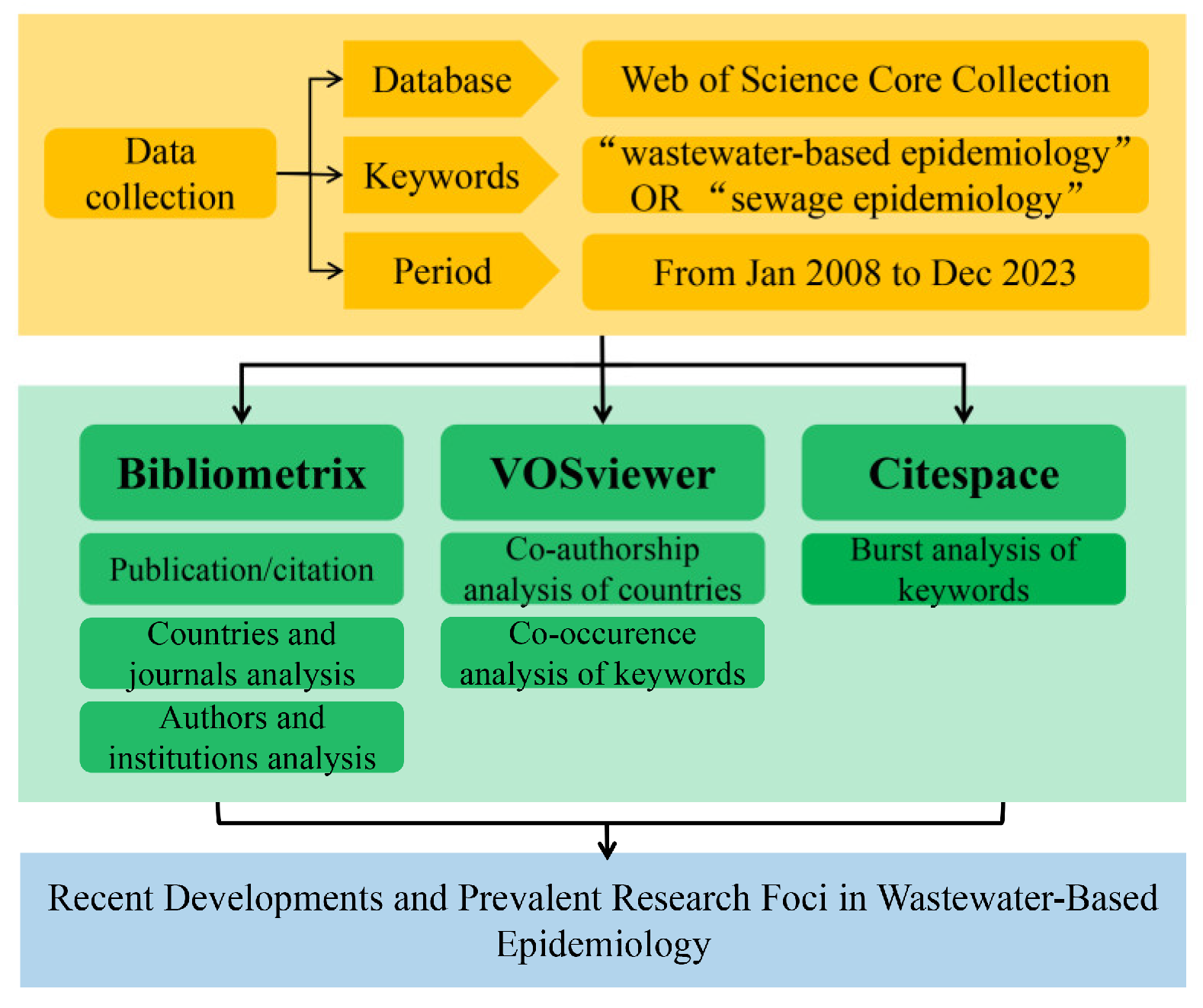
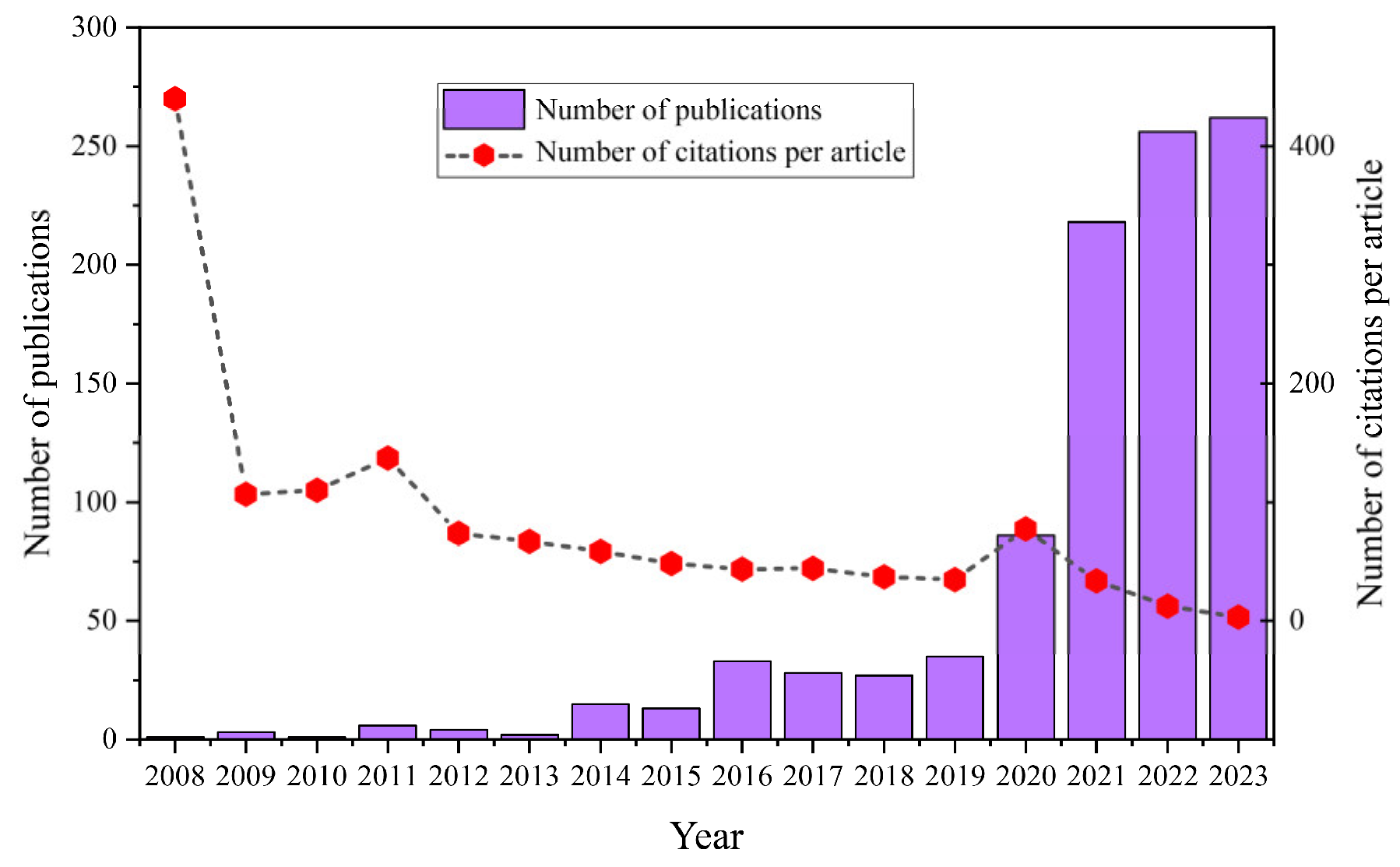
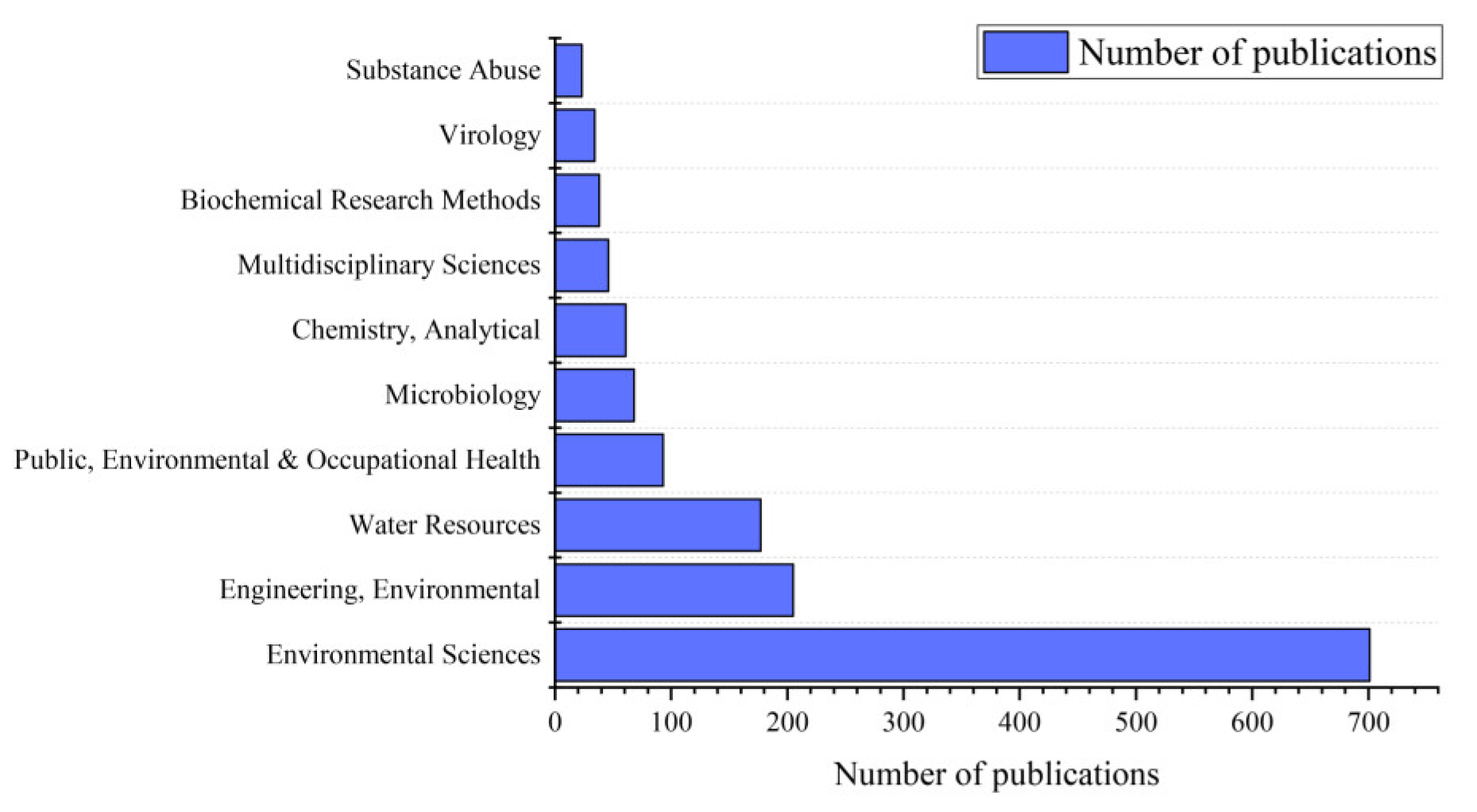
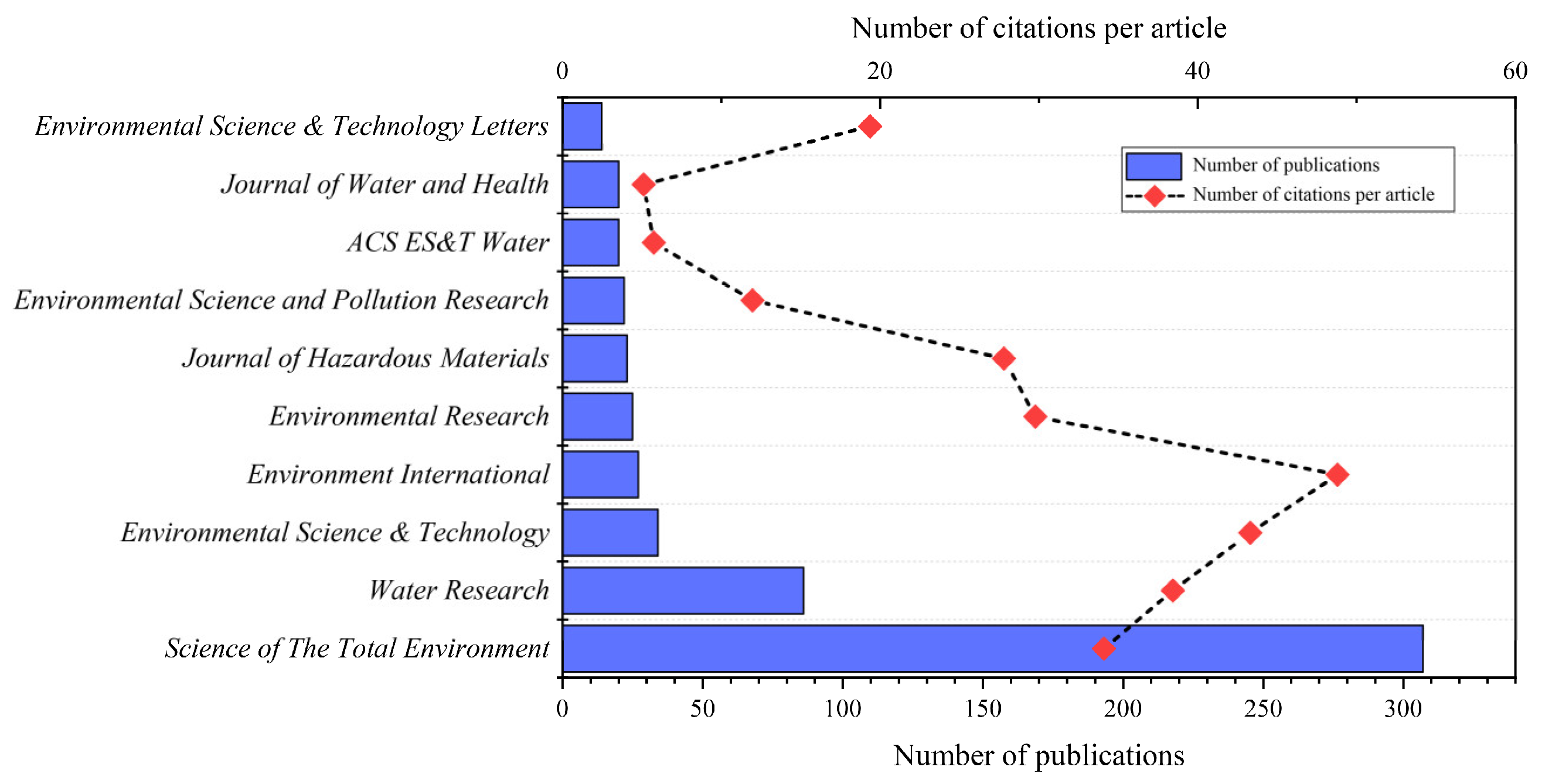
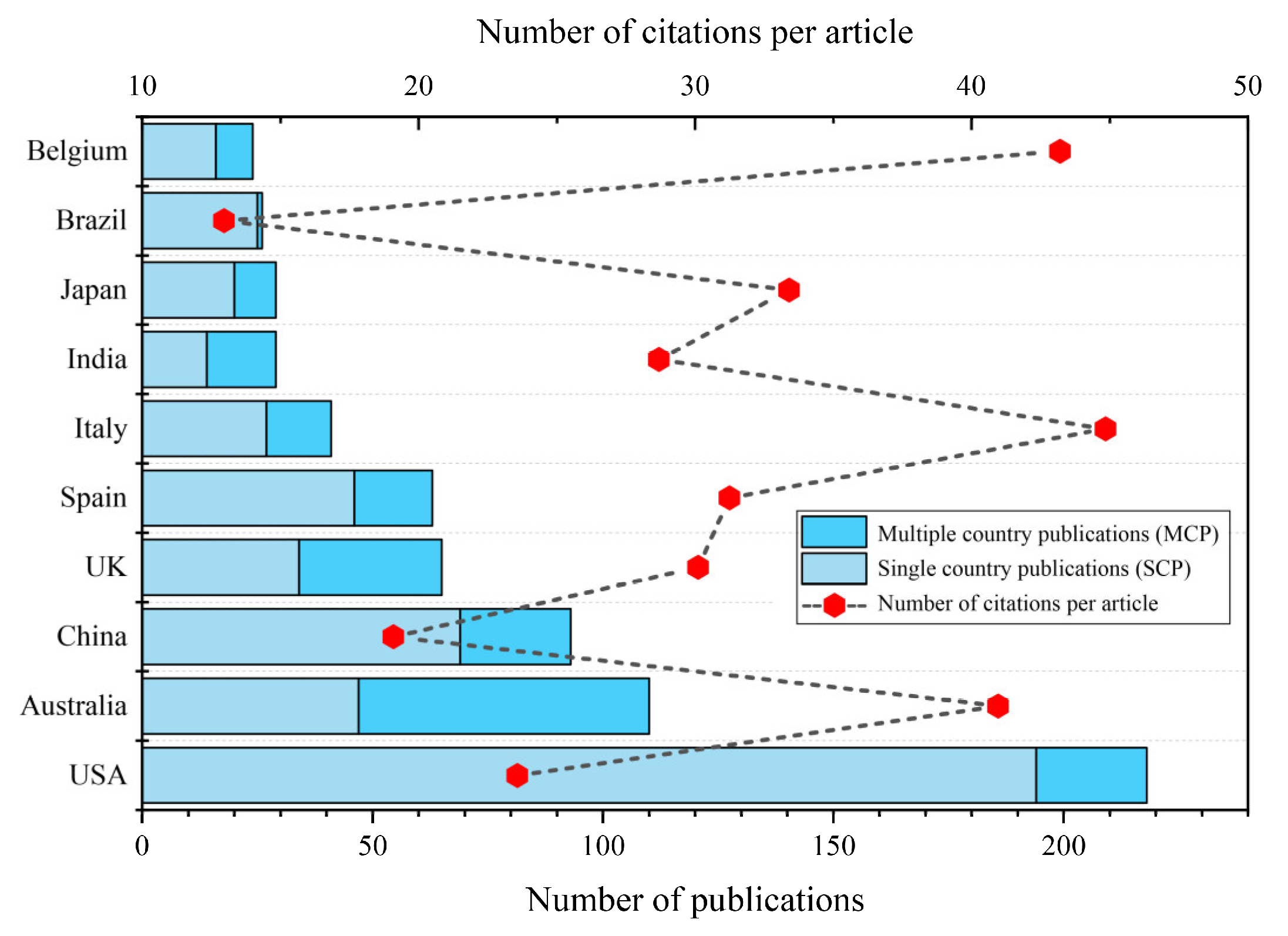
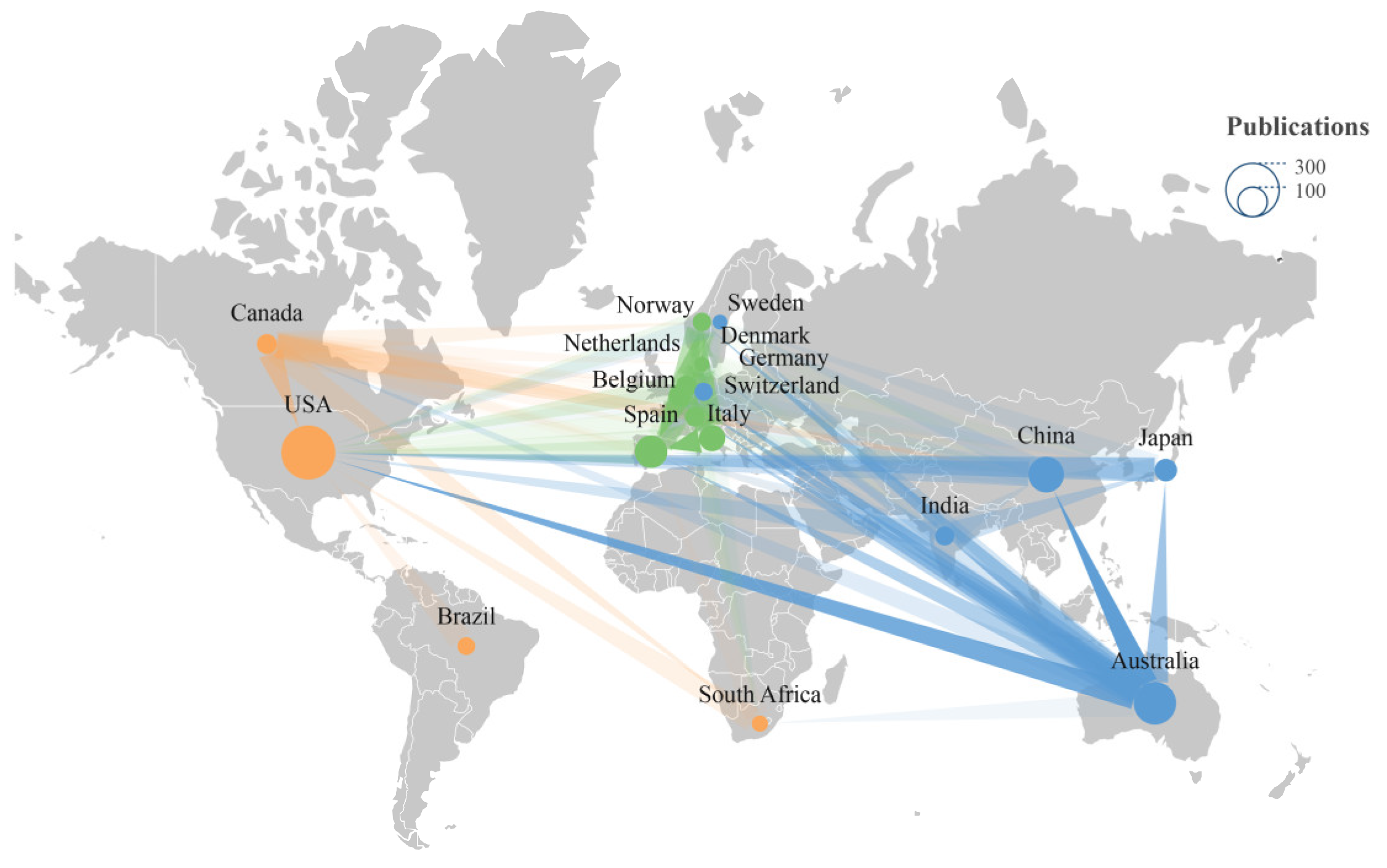

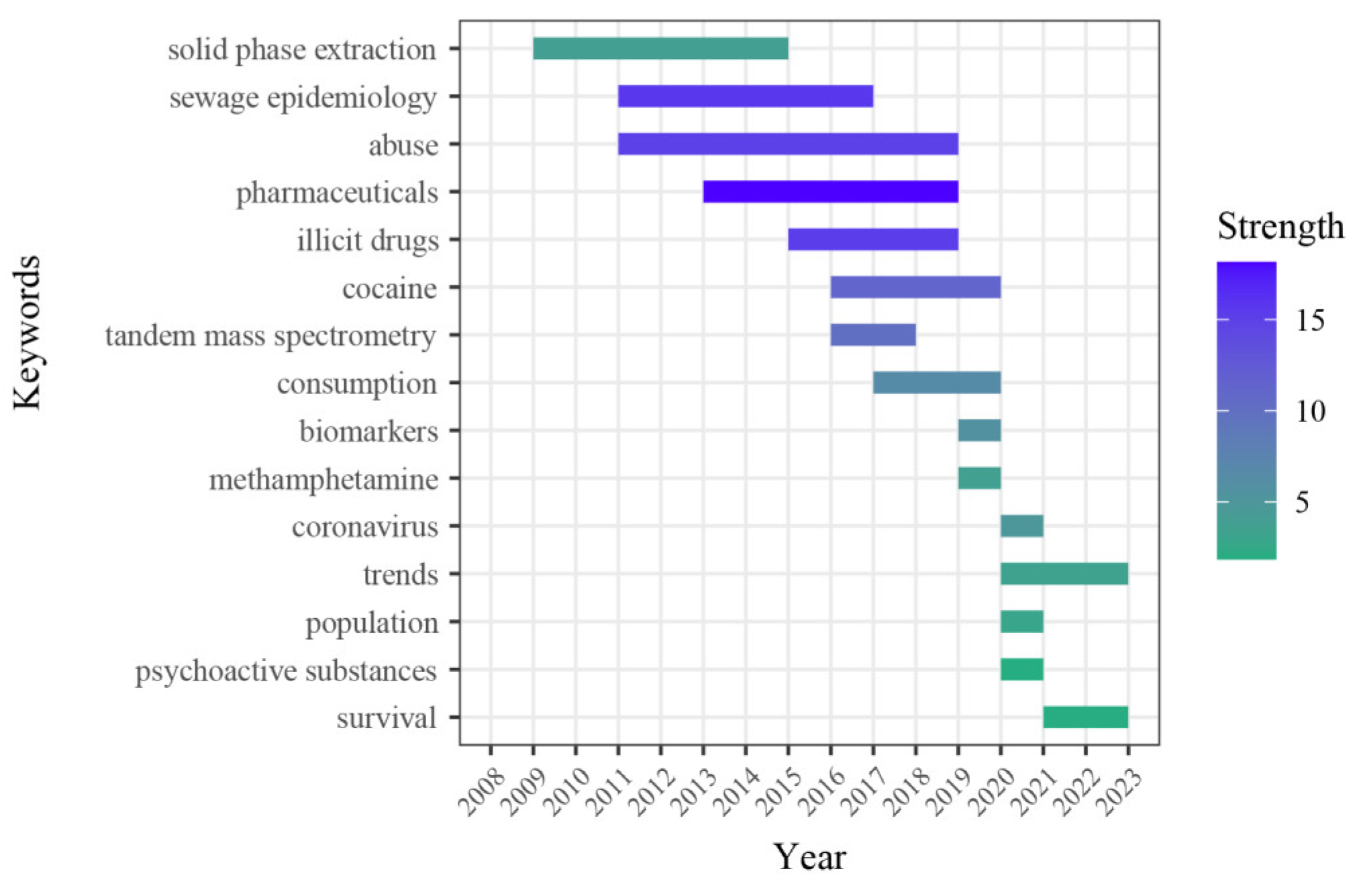
| Institution | Country | Publications | Percentage | Total Cited Citations | Average Cited Citations |
|---|---|---|---|---|---|
| University of Queensland | Australia | 118 | 11.92 | 5093 | 43.16 |
| University of Bath | UK | 51 | 5.15 | 2358 | 46.24 |
| University of Antwerp | Belgium | 48 | 4.85 | 2044 | 42.58 |
| University Jaume I | Spain | 35 | 3.54 | 1271 | 36.31 |
| Arizona State University | USA | 31 | 3.13 | 906 | 29.23 |
| University of South Australia | Australia | 31 | 3.13 | 899 | 29.00 |
| Hokkaido University | Japan | 27 | 2.73 | 2842 | 105.26 |
| University of Amsterdam | The Netherlands | 24 | 2.42 | 844 | 35.17 |
| Universidad de Santiago de Compostela | Spain | 24 | 2.42 | 965 | 40.21 |
| Norwegian Institute for Water Research | Norway | 22 | 2.22 | 1204 | 54.73 |
| Authors | Institution and Country | Publications | Percentage | Total Cited Citations | Average Cited Citations |
|---|---|---|---|---|---|
| Mueller JF | University of Queensland-Australia | 65 | 6.57 | 3603 | 55.43 |
| Thomas KV | University of Queensland-Australia | 59 | 5.96 | 3297 | 55.88 |
| Thai PK | University of Queensland-Australia | 51 | 5.15 | 1558 | 30.55 |
| Kasprzyk-Hordern B | University of Bath-UK | 49 | 4.95 | 2334 | 47.63 |
| O’ Brien JW | University of Queensland-Australia | 42 | 4.24 | 2197 | 52.31 |
| Castiglioni S | Istituto di Ricerche Farmacologiche Mario Negri-Italy | 41 | 4.14 | 2187 | 53.34 |
| van Nuijs ALN | University of Antwerp-Belgium | 37 | 3.74 | 1556 | 42.05 |
| Covaci A | University of Antwerp-Belgium | 34 | 3.43 | 1539 | 45.26 |
| Tscharke BJ | University of Queensland-Australia | 32 | 3.23 | 595 | 18.59 |
| Zuccato E | Istituto di Ricerche Farmacologiche Mario Negri-Italy | 30 | 3.03 | 1819 | 60.63 |
| Rank | Title | Journal | First Author | Country | Year | Total Citations |
|---|---|---|---|---|---|---|
| 1 | First confirmed detection of SARS-CoV-2 in untreated wastewater in Australia: a proof of concept for the wastewater surveillance of COVID-19 in the community | Science of the Total Environment | Ahmed W | Australia | 2020 | 947 |
| 2 | First environmental surveillance for the presence of SARS-CoV-2 RNA in wastewater and river water in Japan | Science of the Total Environment | Haramoto E | Japan | 2020 | 448 |
| 3 | Estimating community drug abuse by wastewater analysis | Environmental Health Perspectives | Zuccato E | Italy | 2008 | 440 |
| 4 | First detection of SARS-CoV-2 RNA in wastewater in North America: a study in Louisiana, USA | Science of the Total Environment | Sherchan S P | USA | 2020 | 346 |
| 5 | Future perspectives of wastewater-based epidemiology: monitoring infectious disease spread and resistance to the community level | Environment International | Sims N | UK | 2020 | 310 |
| 6 | Comparison of virus concentration methods for the RT-qPCR-based recovery of murine hepatitis virus, a surrogate for SARS-CoV-2 from untreated wastewater | Science of the Total Environment | Ahmed W | Australia | 2020 | 306 |
| 7 | First proof of the capability of wastewater surveillance for COVID-19 in India through detection of genetic material of SARS-CoV-2 | Science of the Total Environment | Kumar M | India | 2020 | 303 |
| 8 | COVID-19 surveillance in Southeastern Virginia using wastewater-based epidemiology | Water Research | Gonzalez R | USA | 2020 | 284 |
| 9 | Molecular diagnosis of COVID-19: challenges and research needs | Analytical Chemistry | Feng W | Canada | 2020 | 249 |
| 10 | Detection of SARS-CoV-2 in raw and treated wastewater in Germany–suitability for COVID-19 surveillance and potential transmission risks | Science of the Total Environment | Westhaus S | Germany | 2021 | 237 |
Disclaimer/Publisher’s Note: The statements, opinions and data contained in all publications are solely those of the individual author(s) and contributor(s) and not of MDPI and/or the editor(s). MDPI and/or the editor(s) disclaim responsibility for any injury to people or property resulting from any ideas, methods, instructions or products referred to in the content. |
© 2024 by the authors. Licensee MDPI, Basel, Switzerland. This article is an open access article distributed under the terms and conditions of the Creative Commons Attribution (CC BY) license (https://creativecommons.org/licenses/by/4.0/).
Share and Cite
Yang, F.; Jin, F.; Song, N.; Jiang, W.; Bai, M.; Fu, C.; Lu, J.; Li, Y.; Li, Z. Research Progress and Perspectives on Wastewater-Based Epidemiology: A Bibliometric Analysis. Water 2024, 16, 1743. https://doi.org/10.3390/w16121743
Yang F, Jin F, Song N, Jiang W, Bai M, Fu C, Lu J, Li Y, Li Z. Research Progress and Perspectives on Wastewater-Based Epidemiology: A Bibliometric Analysis. Water. 2024; 16(12):1743. https://doi.org/10.3390/w16121743
Chicago/Turabian StyleYang, Fang, Fangyuan Jin, Nannan Song, Weilong Jiang, Miaoxin Bai, Chenxing Fu, Jinxia Lu, Yuxin Li, and Zhonghong Li. 2024. "Research Progress and Perspectives on Wastewater-Based Epidemiology: A Bibliometric Analysis" Water 16, no. 12: 1743. https://doi.org/10.3390/w16121743
APA StyleYang, F., Jin, F., Song, N., Jiang, W., Bai, M., Fu, C., Lu, J., Li, Y., & Li, Z. (2024). Research Progress and Perspectives on Wastewater-Based Epidemiology: A Bibliometric Analysis. Water, 16(12), 1743. https://doi.org/10.3390/w16121743







